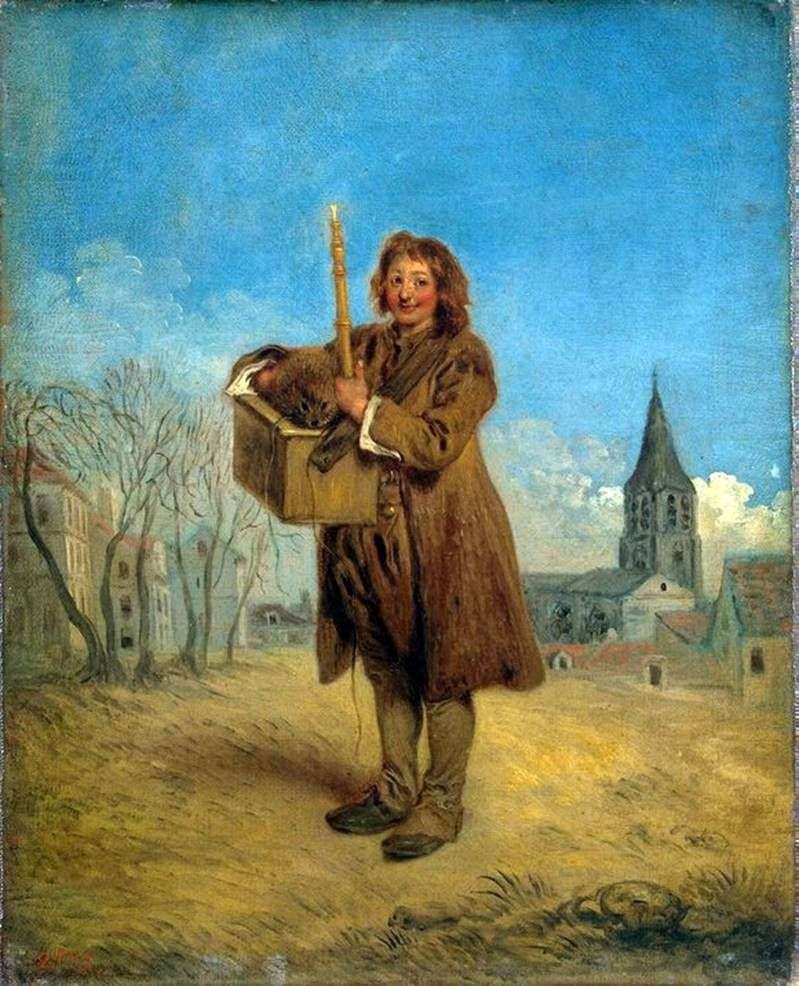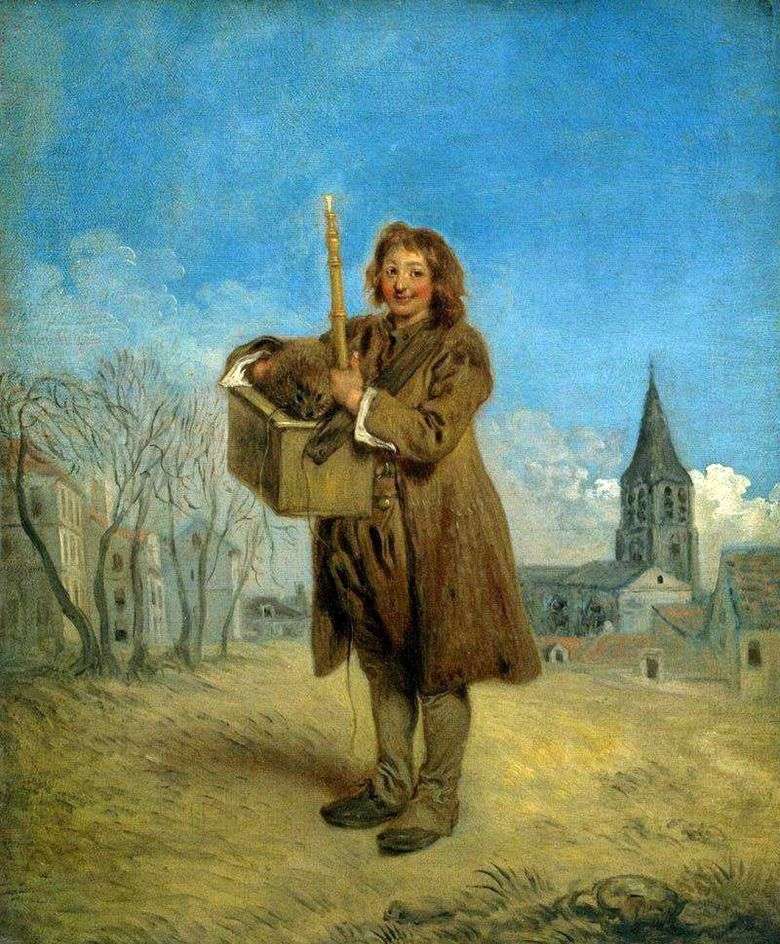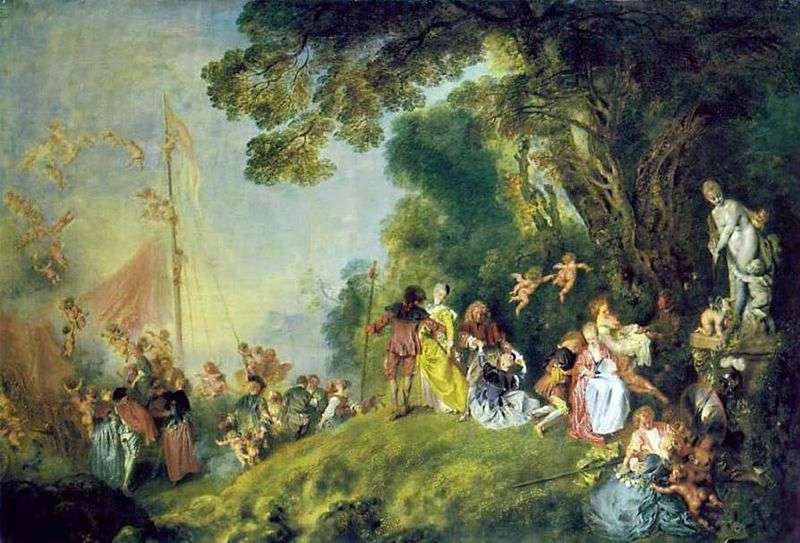
Painting of French artist Antoine Watteau “Savoyard with marmot”. The size of the picture is 41 x 33 cm, canvas, oil. The picture is also known under the names “Boy Savoyard with Marmot” and “Charman with a marmot”. Early small genre scenes – depicting an amusing street scene, a wandering rogue with a marmot, episodes from a soldier’s life – reveal the sharpness and originality of Watteau’s perception of the world, the artist undoubtedly seeks value not in the pretentious art of the era of King Louis XIV, but refers to the art of the 17th century – Peasant genres of Louis Lenen, Kallo’s graphic, Flemish and Dutch masters.
Painting of French artist Antoine Watteau “Savoyard with marmot”. The size of the picture is 41 x 33 cm, canvas, oil. The picture is also known under the names “Boy Savoyard with Marmot” and “Charman with a marmot”. Early small genre scenes – depicting an amusing street scene, a wandering rogue with a marmot, episodes from a soldier’s life – reveal the sharpness and originality of Watteau’s perception of the world, the artist undoubtedly seeks value not in the pretentious art of the era of King Louis XIV, but refers to the art of the 17th century – Peasant genres of Louis Lenen, Kallo’s graphic, Flemish and Dutch masters.
One of the most remarkable French artists of the early XVIII century, Antoine Watteau violated the traditions of academic art and created new genres in painting. He wrote “gallant festivities,” depicting entertainment in the bosom of nature, concerts, conversations at the edge of parks. Watteau wrote “theater scenes”, sometimes relocating actors who had not yet taken off their costumes and make-up from the scaffolding to the same parks and forced to play out the situations invented by himself. A large series of works depicts military everyday life, as if seen by the eyes of a soldier, exhausted by the marching life. Finally, works of the Savoyard type, performed not without the influence of Flemish artists, in their own way continue the line of the genre of the French realists of the XVII century-the Lenen brothers.
“Savoyard” – one of the best adornments of the collection of French paintings in the Hermitage. The painting stops the attention both by the quality of the painting, and by the expressiveness of the image of a boy of about twelve, with a simple, open face. He has modest clothes, adapted to a distant journey. This is one of the poor people of the mountain Savoy, going to wander in the hope of earning. With him is a flute, a box and a learned marmot who knows how to “guess”, pulling out notes with “happiness.”
“Savoyar”, despite the perfection of performance, was long considered one of the earliest, almost student works of Watteau. This view was justified by the fact that the traces of the influence of Flemish painting, which were noticeable in the picture, were supposedly characteristic only for the early period of the artist’s creative work, and, besides, belonging to Savoyard and now lost to him the painting “Pryakha” K. Odran – teacher Watteau. But these proofs are easy to refute: the Flemish influences are noticeable in Watteau’s mature work, and Odran could get the paintings after the young artist left his studio.
The present date of writing the picture is established as follows: the etude, on which, besides the spinning girl, the head of another, partially covered with a figure of a spinner, is preserved. This same head is constantly found in Watteau’s works of 1715-1716. Hence, by the same time, and its etude, and “overlapping” his sketch “Pryakhi” naturally can not be earlier. The “Savoyard” painting by the “Pryah” steam room was performed simultaneously with it, ie, during the heyday of the artist’s work. This conclusion is very important, as it was usually believed that Watteau turned to realistic everyday subjects only in the early years of creativity, accidentally and only imitating the Flemish masters. Now it is clear that in the mature period he created a series of drawings and paintings,
The painting was purchased for the collection of Catherine II between 1774 and 1797 years.
 Dance by Jean Antoine Watteau
Dance by Jean Antoine Watteau Savoyard con una marmota – Jean Antoine Watteau
Savoyard con una marmota – Jean Antoine Watteau Diana by the stream by Jean Antoine Watteau
Diana by the stream by Jean Antoine Watteau Scene in the Italian Theater by Jean Antoine Watteau
Scene in the Italian Theater by Jean Antoine Watteau A company in the bosom of nature by Jean Antoine Watteau
A company in the bosom of nature by Jean Antoine Watteau Dressing by Jean Antoine Watteau
Dressing by Jean Antoine Watteau The Love Gamma by Jean Antoine Watteau
The Love Gamma by Jean Antoine Watteau Arrival to the island of Kiefer by Jean Antoine Watteau
Arrival to the island of Kiefer by Jean Antoine Watteau